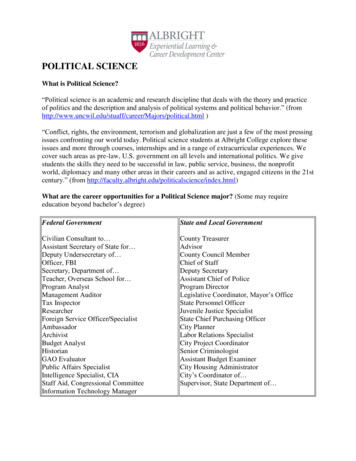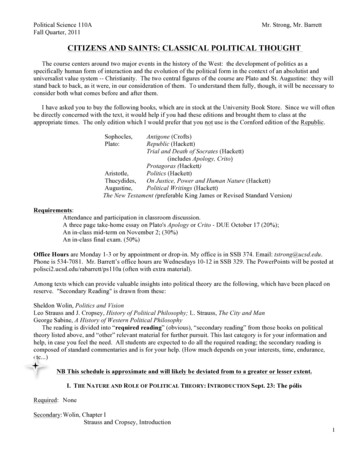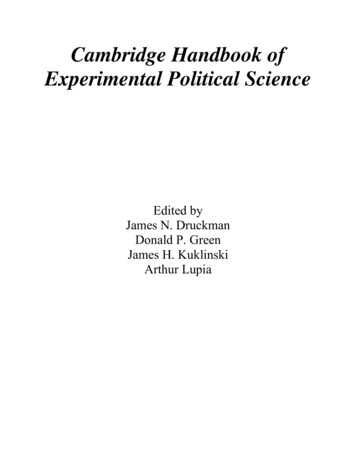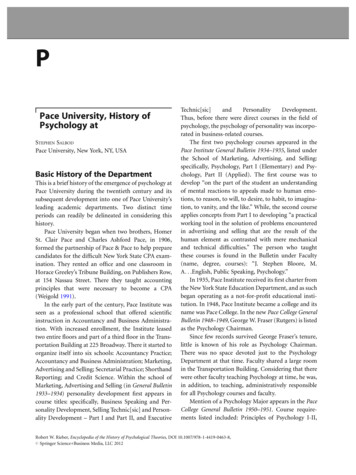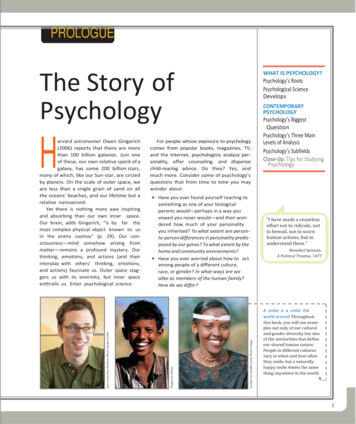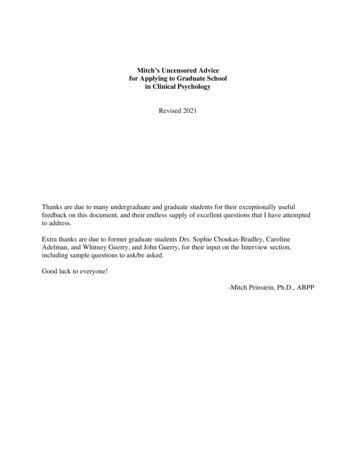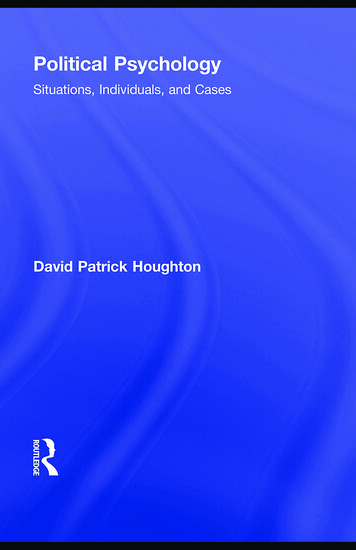
Transcription
Political PsychologyWhat shapes political behavior more: the situations in which individuals findthemselves, or the internal psychological makeup—beliefs, values, and soon—of those individuals? This is perhaps the leading division within the psychological study of politics today. Political Psychology: Situations, Individuals, andCases provides a concise, readable, and conceptually organized introduction tothe topic of political psychology by examining this very question.Using this situationism–dispositionism framework—which roughly parallels the concerns of social and cognitive psychology—this book focuses on suchkey explanatory mechanisms as behaviorism, obedience, personality, groupthink, cognition, affect, emotion, and neuroscience to explore topics rangingfrom voting behavior and racism to terrorism and international relations.Houghton’s clear and engaging examples directly challenge students toplace themselves in both real and hypothetical situations which involve intensemoral and political dilemmas. This highly readable text will provide studentswith the conceptual foundation they need to make sense of the rapidly changing and increasingly important field of political psychology.David Patrick Houghton is Associate Professor of Political Science at theUniversity of Central Florida.
Political PsychologySituations, Individuals, and CasesDavid Patrick Houghton
First published 2009by Routledge270 Madison Ave, New York, NY 10016Simultaneously published in the UKby Routledge2 Park Square, Milton Park, Abingdon, Oxon OX14 4RNRoutledge is an imprint of the Taylor & Francis Group,an informa businessThis edition published in the Taylor & Francis e-Library, 2008.“To purchase your own copy of this or any of Taylor & Francis or Routledge’scollection of thousands of eBooks please go to www.eBookstore.tandf.co.uk.” 2009 Taylor and FrancisAll rights reserved. No part of this book may be reprinted orreproduced or utilized in any form or by any electronic,mechanical, or other means, now known or hereafter invented,including photocopying and recording, or in any informationstorage or retrieval system, without permission in writing fromthe publishers.Trademark Notice: Product or corporate names may betrademarks or registered trademarks, and are used only foridentification and explanation without intent to infringe.Library of Congress Cataloging-in-Publication DataHoughton, David Patrick.Political psychology : situations, individuals, and cases / DavidPatrick Houghton.p. cm.Includes bibliographical references and index.1. Political psychology. I. Title.JA74.5.H68 2008320.01′9—dc222008019240ISBN 0-203-88911-8 Master e-book ISBNISBN10: 0–415–99013–0 (hbk)ISBN10: 0–415–99014–9 (pbk)ISBN10: 0–203–88911–8 (ebk)ISBN13: 978–0–415–99013–4 (hbk)ISBN13: 978–0–415–99014–1 (pbk)ISBN13: 978–0–203–88911–4 (ebk)
ContentsList of Figures and TablesPrefaceINTRODUCTION1 The Conceptual Scheme of This Book2 A Brief History of the Disciplineviiix1322PART IThe Situation3456Behaviorism and Human FreedomThe Psychology of ObedienceCreating a “Bad Barrel”Group Decision-Making3537465769PART IIThe rsonality and BeliefsCognitionAffect and EmotionNeuroscience
viContentsPART IIIBringing the Two Together12 The Psychology of Voting Behavior13 The Psychology of Nationalism, EthnicConflict, and Genocide14 The Psychology of Racism and PoliticalIntolerance15 The Psychology of Terrorism16 The Psychology of International Relations17 Conclusion: A Personal ViewNotesIndex155157168184201216232242267
List of Figures and TablesFigures2.1 The relationship between political science andother fields4.1 The cards used in Solomon Asch’s experimentson social pressure5.1 M.C. Escher’s “Circle Limit IV”5.2 Zimbardo’s interpretation of the Stanford experiment5.3 One of the photos released in 2004 showingU.S. servicemen torturing detainees at Abu Ghraib prison2348586164Tables2.1 A summary of the features of the Homoeconomicus and Homo psychologicus models3.1 A summary of the arguments for and againstbehaviorism4.1 A summary of some of the arguments for andagainst Milgram’s obedience paradigm5.1 A summary of the arguments for and againstZimbardo’s “bad barrel” approach7.1 Barber’s characterization of modern presidents16.1 Solidarity and Status dimensions3245566795223
PrefaceFor almost as long as I can remember, I have always been interested in thecauses of political, economic, and other social behaviors, though it took me along time to realize that what I was most interested in had a name and formedan academic field in its own right: “political psychology.” In fact, it was notuntil I moved to the United States as a graduate student that I found what I waslooking for. I was raised in the British university system, and cannot recall theterm ever being used during my undergraduate years at Sheffield University(though thankfully it is now widely taught in Britain). I had begun my highereducation as a student of economics. Rather naively believing that I would learnsomething about the causes of human economic behavior from microeconomics, I was dismayed to find that many economists simply assumed various thingsto be true about human behavior—treating them as “givens”—and then usedthese assumptions to build models of various sorts.There is a very old joke about an engineer, a priest, and an economist whohave fallen down a cavernous hole. Naturally, they begin debating a way to getout of this predicament, and after a little thought each comes up with a proposal. The engineer says “let’s make footholds at various points by climbing onone another’s shoulders, which will enable us to clamber out of the hole.” Thepriest goes next, and not unexpectedly offers a more spiritual solution. “Let usall join hands and pray to God. He will find an answer to our problem.” Then itis the economist’s turn. He thinks a bit more for a moment, and then simplysays to the others, “assume a ladder!” The microeconomics teachers tried invain to fill my head with preference curves and shifting lines on graphs, based onassumptions about human behavior (perfect information, the non-existence ofadvertising, and so on) which they admitted were manifestly untrue. Theynevertheless recommended proceeding (after Milton Friedman) “as if ” theywere true. This was definitely not what I was looking for, and I didn’t last longat it. I didn’t want to assume anything about human behavior. I wanted to knowhow people actually thought in the real world, and why.
xPrefaceThough it had no course in political psychology per se, the Department ofPolitics at Sheffield nevertheless provided me with an excellent undergraduateeducation. The consistently fascinating political theorist Anthony Arblasterintroduced me to Stanley Milgram’s electric shock experiments and to HannahArendt’s book on the banality of evil, Eichmann in Jerusalem, both works whichare discussed later in this book and which fascinate me to this day. At the sametime, in my first year I took courses in the Psychology Department, butwhatever they tried to teach me didn’t really stick in my mind for long. Theyseemed more interested in observing the learning behavior (or otherwise) oflaboratory rats, writing up endless research designs and talking about thephysiological makeup of the brain. Ironically, I would later see how importantthese are to an understanding of political behavior, but at the time I came awaywith the distinct but utterly mistaken impression that psychology and politicalscience were almost hermetically sealed disciplines with very little to sayto one another. In my second year I was required to pick either psychology orpolitics, and politics, which I had realized is interested in the empirical studyof voting behavior, for instance, not just in assumptions about how people voteor ought to do so, seemed the more promising route at the time.It was not until I arrived in the United States for the first time in my earlytwenties that I gradually began to get the sense that the field this book coversactually existed. I had chosen another excellent place to study—the Department of Political Science at the University of Pittsburgh, a location grittilysimilar to its post-industrial steel town cousin in England, Sheffield. One of mygreatest regrets about my student years is that I never got a chance to take acourse with the late, great Herbert Simon of Carnegie Mellon University, forif I had, all would have been revealed much earlier than it was. As a Universityof Pittsburgh student, it was possible to cross-register for courses at CarnegieMellon (which is a matter of minutes away from Pitt on foot), but Simon was alegend across a variety of academic fields, and his courses were always full. Iwas lucky enough at Pitt to take Jon Hurwitz’s “Mass Politics” course, though,which fuelled my interest in the psychology of mass behavior and balanced outmy primary interest in how elites think and act.Ironically it was in one of the last courses I ever took as a student that Ifinally found my calling and belatedly “discovered” the traditions which formthe backbone of this book. At that time, Brian Ripley—who would laterbecome a very good friend and co-author—used to teach a course at Pittsburgh called “Culture and Cognition in Foreign Policy.” I wasn’t at all sureinitially what this title meant, but after talking to Brian I decided to give it atry. The best teacher I’ve ever known, Brian skillfully introduced me to thetopic of foreign policy decision-making, much of which—I found to my greatdelight—actually used cognitive and social psychological theories to explain
Prefacexidecision-making. As I got deeper and deeper into the topic, I realized that thiswas the tradition I had been searching for on and off for years, the tradition notjust of Herbert Simon but of other greats in the field such as AlexanderGeorge, Robert Jervis, Ole Holsti, Ned Lebow, and others. I wrote a PhDdissertation on the topic of analogical reasoning in domestic and foreign policy,later wrote a book about decision-making during the Iran hostage crisis fromthis perspective, and have been publishing articles on this subject and othersnow for a decade or so. I have consciously tried, though, not to overload thisbook with my own rather humble contributions.While a couple of excellent textbooks introducing students to politicalpsychology have recently been published—after a long period in which virtually all of the existing texts had gone out of print—neither quite mirrors what Ilike to teach my undergraduates closely enough. That is understandable: political psychology is a highly idiosyncratic discipline, and different professorsteach it in different ways. I wrote this book for the same reason many academics write textbooks: I could not find an existing work that covered in a singlevolume all the things I wanted to talk about. In particular, I wanted to write abook which (a) would define “political psychology” broadly to include work bypsychologists and researchers who—while writing about inherently politicaltopics—did or do not primarily identify themselves as “political” psychologists,(b) would do equal justice to the situationist and dispositionist traditions withinpsychology, and (c) included a general introduction that would have some sortof explicit organizing device that would be useful for teaching purposes. Sohere it is. Naturally, I hope it serves these purposes for others as well, or atleast that it will convince others who teach courses called “political psychology” to include weeks on subjects dealt with here that they would notnormally have covered. I hope it will also serve as a useful introductory textboth for those who specialize in mass political behaviors such as electoralchoice and those who examine leaders and elites in the context of internationalrelations and foreign policy. All too often, these two “camps” within politicalpsychology proceed independently of one another, but I hope this book willappeal to specialists within both.Various people helped me during the writing of this book. I would especiallylike to acknowledge the help of Anna Carroll, Michael Kerns, Sarah Phillips,and Elizabeth Renner at Routledge: Michael in particular encouraged me topursue this project when it was just a sketchy idea on an email attachment, andthe expert editing of Anna and Elizabeth improved the manuscript immeasurably. Various anonymous reviewers also provided helpful comments whichhave been incorporated into the text. Marco Iacoboni of UCLA and JeffBedwell of UCF both helped me considerably with ideas for Chapter 11 onneuroscience, a topic which was mostly new to me since when I received my
xiiPrefacePhD it was but a glint in the eye of most political psychologists (if that). Jeffwas also kind enough to read an earlier draft of that chapter, patiently correcting some of my misconceptions. David Pearl of Washington State Universityalso stimulated my interest in the topic of neuroscience, and I thank him forprompting me to catch up with some of the most cutting-edge methods thattoday’s political psychology graduate students are being taught. StephenDyson, a former student of mine from my time at Essex University and now anassistant professor at the University of Connecticut, had a similar effect on mewith regard to the latest work that’s being done on operational code analysis,and I thank him also.During the writing of this book, I tried out the drafts of most of the chapterson my students in POS4206 Political Psychology at UCF. My thanks are due toeveryone in those classes who served as guinea pigs for my ideas and rough firstefforts. Special thanks are due to those class members who offered me comments, advice, and encouragement along the way, even if it was sometimes justpointing out typos and misnamed TV shows I had referenced! I would especially like to acknowledge (in alphabetical order) Dacia Anderson, FrederickAyer, Brendan Byrne, Michael Carrano, Travis Dawry, Lacey Fitzpatrick,Maggie Fundora, Dale Greenstein, Patrick Hines, Kenny Klamper, BennettLessmann, David Magovern, Genevieve Napolitano, and Kimberleigh Swift. Iknow you will all go on to do great things in life.This book, like its predecessors, would not have been possible were it notfor the constant love and encouragement of my parents. My time in furthereducation would also have been impossible without their financial bail-outs ofmy overdrawn bank accounts along the way, and I thank them for that too.Finishing a book also allows you to spend a lot more time with your immediatefamily as well, who always suffer from neglect when you are closed away in aroom tapping on the computer keys. I thank my wife Annabelle, daughterIsabelle and son Carlos for their love and patience, especially Annabelle, whodutifully entertained the kids at places like Disneyworld and Universal Studioswhile Dad stayed home writing, napping between paragraphs, and having theoccasional Margarita for inspiration. Hopefully, my fathering techniques willimprove from now on.Orlando, FloridaApril 2008
Introduction
Chapter 1The Conceptual Scheme ofThis BookThe photographs did not lie. American soldiers, male and female, grinningand pointing at the genitals of naked, frightened Iraqi prisoners; an Iraqiman, unclothed and leashed like a dog, groveling on the floor in front of hisfemale guard; a prisoner standing on a box with a sandbag over his head andwires attached to his body beneath a poncho. These were not enemypropaganda pictures; these showed real atrocities actually inflicted byAmericans.1In early 2004, The New Yorker and the CBS program 60 Minutes II shockedAmerica and the world by publishing revolting pictures of the torture andhumiliation of detainees by American soldiers at the now infamous Abu Ghraibprison in Iraq. Ironically, the prison had been used for years to house anyonewhom Iraq’s former dictator Saddam Hussein considered a potential enemy orthreat to his power, and countless Iraqis had undergone agonizing torture and/or summary execution there. And now here were the representatives of theUnited States, supposedly Iraq’s liberator, engaging in human rights abuses,and capturing it on film. More than anything else, perhaps, the pictures didmost to undermine America’s legitimacy in Iraq early on. After numerousinvestigations narrowly confined to the lowest level of the chain of command,seven individuals were eventually put on trial for the abuses committed at AbuGhraib.In his marvelous book The Lucifer Effect, social psychologist Philip Zimbardoargues that the scandal at Abu Ghraib—in which ordinary, psychologically“normal” prison guards tortured and humiliated Iraqi prisoners—was in largepart a result not of the characteristics of the individuals themselves, but ofthe strong situational forces they faced.2 As Zimbardo puts it, he was “shockedbut not surprised” by the horrors of Abu Ghraib when the scandal erupted inMay 2004, as dramatic images of prisoner abuse spread around the world viatelevision and the internet:
4IntroductionThe media and the “person in the street” around the globe asked how suchevil deeds could be perpetrated by these seven men and women, whommilitary leaders had labeled as “rogue soldiers” and “a few bad apples.”Instead, I wondered what circumstances in that prison cell block couldhave tipped the balance and led even good soldiers to do such bad things.To be sure, advancing a situational analysis for such crimes does not excusethem or make them morally acceptable; rather, I needed to find the meaning in this madness. I wanted to understand how it was possible for thecharacters of these young people to be so transformed in such a short timethat they could do these unthinkable deeds.3Zimbardo’s handy distinction between “the apple” and “the barrel” providesa useful way of explaining what we mean by the terms situationism and dispositionism, a distinction that is going to be critical to this entire book. Were theappalling events at Abu Ghraib caused by “bad apples,” or was the barrel itselfturning the apples inside it rotten? In this book, situationism is defined as anapproach in which the environment or situation that surrounds the individual—in Zimbardo’s terms, “the barrel”—is considered most important in shaping anactor’s behavior; dispositionism, on the other hand, is defined as an approach inwhich the individual actor—his or her beliefs, values and personality, or “theapple” in Zimbardo’s parlance—are considered most significant in this respect.We can think of behavior as driven by internal causes (dispositions) or externalcauses (situations), or of course by some combination of both. Within thesituational camp there are various forms of external causes that are held toshape behavior, from the position our country occupies within the internationalsystem to the immediate social roles we play in our daily lives. Inside thedispositionist approach, a diversity of approaches as to what causes thebehaviors of individuals—their knowledge structures, beliefs, personalities,and so on—are present as well. We will use this simple distinction to explainand contrast a variety of psychological theories of relevance to an understanding of politics, and then show how these can be used to explain genocide,voting behavior, racism, nationalism, conflict between states, and a variety ofother political behaviors.The distinction between dispositional and situational factors as forces actingon behavior has long been central to social psychology, and it continues to beutilized by major scholars in that field today.4 Many social psychologists comedown on the situationist side of the debate. Most of us, on the other hand, areinstinctive dispositionists. We like to think that who we are—what we believeabout the world and the kind of personality we have—exerts a fundamentalimpact on our behavior. Our political and legal systems largely just assume thatthis is so, holding us primarily responsible for our actions.5 We tend to recoil
The Conceptual Scheme of This Book5from the view presented by much research in social psychology, which suggeststhat (for most people, at least) the character of the situation we are facing—where we are—matters more than our own characters to a greater extentthan we could ever imagine. And we like to think that our political behaviors—how we vote, what form our political participation takes, how tolerant we areand so on—are shaped by who we are as well. But is this true? This is thecentral question this book poses and the issue around which the organization ofthe book revolves.One interesting thing to note is that this kind of distinction between theindividual and his or her environment appears in practically every disciplinewhich analyzes social behavior. In political science and especially in the subfieldof international relations, a distinction is drawn between “levels of analysis” or“agents” and “structures.”6 International relations theory reflects a divisionbetween dispositionists (especially those who study the psychological aspects offoreign policy decision-making) and situationists (including neorealists likeKenneth Waltz and neoliberals like Robert Keohane). In the analysis of foreignpolicy, situationist theories do exist, but have been drawn mostly from organizational theory rather than social psychology.7 In economics, there is a commondistinction made between macro– and microeconomics (the latter examiningthe economics of the individual business or firm, the former the workings ofthe whole economy). In sociology, history, and other disciplines, there has longbeen a similar debate between those who believe that individuals drive eventsand those who counter that situational forces are more critical.Another thing that is interesting to note is that political psychology has drawnoverwhelmingly from the dispositionist side of the mother discipline of psychology. As Rose McDermott notes, much political psychology—at least as conventionally defined as an academic “discipline”—operates at the individual levelof analysis,8 or is dispositionist in the sense that it assumes that individual actors“matter” and that their behavior can be traced to meaningful differences in ourbeliefs and personalities. Nevertheless, a large body of work within socialpsychology is far more hospitable to situationism than it is to dispositionism.Research on the ways in which social situations can shape behavior has had lessimpact on the development of political psychology than have Freudianisism andmodern cognitive psychology, each of which studies the human mind (though inrather different ways). Moreover, it is not always acknowledged in literature onpolitical psychology that the findings of social psychologists like Stanley Milgramand Philip Zimbardo among others—though profoundly political in theirimplications—depart significantly from the idea that individual attributes arecritical in shaping an individual’s behavior. The reasons for this are unclear, butwe shall spend a good half of this book looking at prominent situationist arguments that attempt to explain some fundamental aspects of political behavior.
6IntroductionWhat is Political Behavior?This is a book about political behavior, so it makes sense to be very clear at theoutset what this term means. Broadly defined, political behavior refers toany type of activity designed to meet some political end. It encompasses thefull range of political activities in which human beings engage, from extremebehaviors like terrorism and war to more “mundane” behaviors such as theact of voting. It includes the study of decision-making—both by voters andby elites in government—but is broader than this. It also encompasses questions as diverse as “why does racism occur?,” “why do human beings engage ingenocide?,” “what determines how people vote?,” and “why do states go towar?” As you will see in what follows, there are different ways of answeringthese questions. Some follow the logic of economics in assuming that humanbeings are fundamentally rational, weighing up the costs and benefits of variousactions available to them, while others are inspired by the social or group focusof sociology. Political psychologists, therefore, offer only one set of answersto questions like those posed above. Nevertheless, the purpose of this book isto show how compelling such answers can be.What Determines our Behavior?As Susan Fiske and Shelley Taylor (two prominent social psychologists) note, itcan be hard to tell in practice whether a person’s behavior is driven by theexternal situation or by his or her internal dispositions. They provide a tellingexample. “If Beth is a mean, aggressive person to others because her sister beather up as a kid,” they ask, “is the cause of her current behavior internal orexternal?”9 My most astute and thoughtful students eventually come to a realization of this problem when the scheme we will use in this book is presented tothem: there is a sense in which nearly everything, one could argue, is ultimatelysituational. In other words, our cognitive beliefs or schemas—the mentalcategories we use to make sense of the world—are the product of experience.Many if not all of our dispositions presumably result from the situations wehave been through. To employ Fiske and Taylor’s example, there is a sense inwhich Beth’s behavior is situationist because her current behavior derives fromcircumstances she faced in the past.Situationism assumes, of course, that environment is everything. To offerone defense of dispositionism, this argument leaves out the possibility that weare genetically hard-wired—probably as the result of evolutionary mechanismswhich have allowed us to maximize the survival of our species—to behave incertain ways. If this is so, we are born with certain dispositions already prepackaged within us, and it is our dispositions that drive our behavior. It would
The Conceptual Scheme of This Book7then be folly to deny human nature, treating individuals as if they were a “blankslate.”10 To offer another defense of a different kind for dispositionism, weknow that different individuals respond in different ways to the same externalsituation, so what is it within us that shapes behavior? A situationist couldrespond, of course, that these differing individuals were previously exposed todifferent situations, and that it was the situations that shaped the differingdispositions and hence the differing responses. And so on. We could go on andon this way, tracing the story of causation further and further back. In socialscience this is called “infinite regression,” since we can keep on regressingthrough history, tracing the causes of causes back through time.This is a complexity we shall leave until the conclusion of this book to discuss fully, though for now what follows is a brief overview to provide contextfor later content. For one thing, any good story has to start somewhere; wecannot, for purely practical reasons, consider all of human history in explainingan event. The Vietnam War was arguably caused in part from “overlearning”the lessons of World War II, for instance; World War II, in turn, arose becauseof the way European leaders had reacted to World War I. World War I, in turn,was caused in part by misperceptions between the major powers of the time,and so on and so on. In the comedy movie Airplane II, an oddball air trafficcontroller Jacobs is asked for a briefing on the fate of a missing plane. “Jacobs, Iwant to know absolutely everything that’s happened up till now!” his bossSteven McCroskey demands. Jacobs gives a bizarre answer. “First the earthcooled. Then the dinosaurs came but were too big and died and everything gotrotten and turned into oil and the Arabs bought Mercedes Benzes. . . .” And hegoes on in this vein.In a sense, this is the “correct” answer—the coming and going of the dinosaurs probably is relevant if one wanted to create a full causal history ofeverything that has happened to that point in human history—but the reasonhis response is humorous is that there is a lot that we take as “given” inproviding explanations; the character is violating the social norm that weconventionally leave some things that are considered obvious out of a causalexplanation. We break into the causal chain, often without thinking about it,and consider only the proximate or most recent causes of an event.There is, however, an inherent “gray area” between the concepts of dispositionism and situationism. As noted above, every theory can be characterized assituationist, since our dispositions are partly shaped by the situations we happen to have experienced throughout our lives. But there are two importantpoints that must be made here: first of all, the reader should note that when wecharacterize a theory as “dispositionist,” we mean only that dispositions affectbehavior in a proximate or immediate sense. Although our partisan identifications or our attitudes towards the use of military force may have been shaped
8Introductionby situations originally, these eventually become lasting dispositions which varylittle across elections and wars. Second—and even more importantly—mostdispositionist approaches assume that individuals vary in their reactions tosituations; Colin Powell took different lessons from the Vietnam War, forinstance, than, say, Cyrus Vance or Jimmy Carter. People frequently takediffering internal attitudes and beliefs away from precisely the same externalsituation.There are different forms of dispositionism and situationism. Within thedispositionist school, for instance, there is at least one a key division: althoughboth camps assume that it is our fundamental dispositions (and not the situations we confront) that shape behavior, one approach argues that we havedifferent dispositions to one another; some of us believe X, while othersbelieve Y, and these differi
Political Psychology: Situations, Individuals, and Cases provides a concise, readable, and conceptually organized introduction to the topic of political psychology by examining this very question. Using this situationism–dispositionism framework—which roughly paral-lels the concerns of social and cognit

